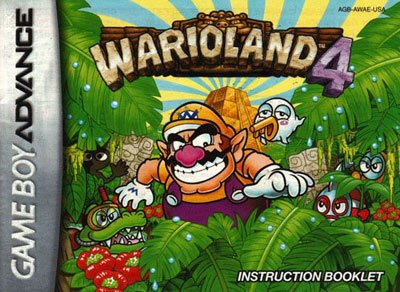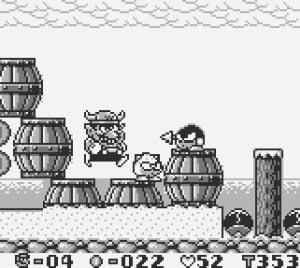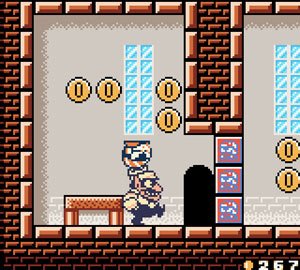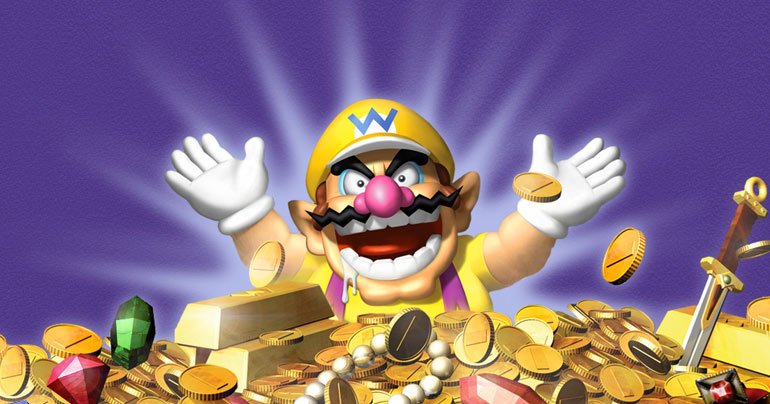The game manual for Wario Land 4 used to be permanently lodged in my pocket so I could draw pictures of Wario whenever and wherever I wanted.
Undeniably, this was mostly in school when I was supposed to be learning. Drawing images of Wario on fire, or with a puffed up face from being stung by a bee, or as a zombie with a fork jabbed into his torso taught me a valuable lesson. Don’t take yourself too seriously.

The Colossal Hole
Wario is probably my favourite video game character, and yet this seems to baffle anyone I meet. People can’t seem to fathom why I always have to choose Wario in all Nintendo multiplayer games, and why my Animal Crossing: New Leaf town is filled with Wario imagery. I have to admit that it’s fairly bizarre. I’m writing this article in hopes of exploring who or what Wario actually is, and in the process, discovering what it is about Wario that entices me to his oddity.
Wario, when looking from an outsider’s perspective, is simply perceived as Nintendo’s evil-protagonist cliché, but this isn’t what the character symbolises at all. Labels are meaningless to an enigma such as Wario, who is far more important than his superficial ‘evil-Mario’ stereotype dictates. Wario is an interesting figure, and his legacy is fascinating.

To fully understand and appreciate Wario, it’s best to go back to the very beginning, and look at him in relation to his cleaner mirror image, Mario. If Mario is gaming heaven, Wario is not the polar opposite, gaming hell. I daren’t say Wario is purgatory, even though that seems to fit best with the lack of apparent death the series is known for, but I digress. Wario is more akin to that of the Jungian archetype of the trickster.
Beneath the Waves
Wario’s roots trace back to Foreman Spike in Wrecking Crew on the NES. Designed by Metroid’s Yoshio Sakamoto, the game presents Mario and Luigi with a rival for the very first time. Parallel to Pauline, Mario’s first damsel in distress, Spike is an early prototype to Wario as Pauline is to Peach. He lacks the personality that Wario now embodies, but is an important milestone nonetheless.
Wario’s first true appearance is in Super Mario Land 2: 6 Golden Coins on the Game Boy; directed by Takehiko Hosokawa, a significant figure in Nintendo history, and designed by Hiroji Kiyotake. Working under Gunpei Yokoi’s Research and Development 1 (R&D1), now known as Software Planning and Development (SPD), a certain rivalry sparked the creation of Wario.
Yokoi mentored a young games designer who caused massive shock waves upon the company and the games industry, Shigeru Miyamoto, the creator of Donkey Kong, Super Mario Bros., The Legend of Zelda, and the father of modern video games. His rise created a small rivalry between Miyamoto’s Entertainment Analysis and Development (EAD) and his former mentor Yokoi’s R&D1.
After working on Super Mario Land on the Game Boy, R&D1 grew tired working with Mario as he was not their character They felt the need to symbolise their situation, and consequently Wario was born. Wario’s existence is a metaphorical stamp that documents the duality within Nintendo at the time. If Mario is the heroic face of Nintendo, Wario represents the company’s deepest, darkest intention: greed.
Out of the Woods
After two NES appearances, it was his Game Boy Wario Land series that first upended the proverbial tea-table. Wario Land: Super Mario Land 3 and Virtual Boy Wario Land channelled his personality directly into the gameplay. Being greedy was an intrinsic motivation that translated in coins becoming a narrative system that function as a typical game collectible. Coins in Mario are generally a gameplay system where 100 equal a new life. Wario’s coins are to satisfy his greed; they are for him and him alone. They do function as gameplay and have other uses, but the player inherently connects to Wario’s greed.

Personality translating to gameplay is the fundamental difference between Mario and Wario. Mario’s joyful personality only exists to empower the player into becoming joyful when playing; it never interrupts or interferes with gameplay. Miayamoto would never create a character like Wario, as to him gameplay is the foremost focus of his work. R&D1 effectively used the idea that one can only break the rules once one knows the rules. Mario is the foundation for which R&D1 used to break and rebuild into Wario, which gives Wario a certain mysticism; he becomes the trickster.
Above the Clouds
The trickster archetype in folklore is generally a prank-playing deity who breaks the rules and is neither good nor evil, and mostly foolish. A clown, a jester, a higher force, the trickster exists to elevate the awareness of those around. This archetype is seen in many different cultures, such as Loki in Norse Mythology, Coyote in Native American culture, and Susanoo in Japanese mythology. Even the Joker in Batman can sometimes be said to be this archetype.
I believe Wario is gaming’s trickster. He opposes the conventions of gaming, most notably with his Wario Land series, and is everything from good to evil, and foolish to cunning. He straddles a line, impeccably balancing everything, while still maintaining a high-quality gaming experience.
Wario Land 2 and 3 showcase the meaninglessness of death, by lacking it entirely. The introduction of this gameplay mechanism is ingenious and satisfying, as it directly relates to Wario’s personality as a humorous figure. What is death? We can’t fully answer that in real life, but in a video game, death is usually a system. When you die, you essentially reset the level. Obviously there is a lot more to it than that, but in 2D platform games, this is generally how things work.
Castle of Illusions
Wario, as a trickster, helps to elevate the awareness that death may not be the worst outcome. The bosses in Wario Land 3, instead of killing you, knock you out of the arena. By doing this, the player is forced to return to the boss arena and start again. This is different to the usual game-over and restart. With Wario Land 3, the boss arena is in the level and thus there is no refresh, just a blockade preventing the player from finishing the level. Frustration is then presented as a more engaging instrument than death. Closure is granted with a video game death; you can always try again at a later time. Frustration though, doesn’t give you a break. It’s like a parasitic worm eating at your pride, nagging you to try again, until you do.

Wario Land 3’s Death system upturns conventional normality in favour of tricks being played at the player’s expense. Incredibly hilarious, frustrating, and intelligible, Wario is a satirical, slightly comically anarchic symbol of gaming. The infectious ‘don’t take yourself too seriously’ appeal is imbued in all his games. It’s a shame we haven’t seen a return to form, as I think a true Wario Land successor could help blanket the ‘mature’ emotions of todays gaming landscape with some point-blank absurdity.
This article was written to help me to understand why I like Wario so much. In truth, I’m not sure I’ve answered this question and quite frankly, it matters not. Wario is my favourite games character; he means a lot to me, and being rational only goes against what he stands for. To quote the title of this article, taken from Euripides from his Ancient Greek tragedy The Bacchae, “Talk sense to a fool and he calls you foolish”






